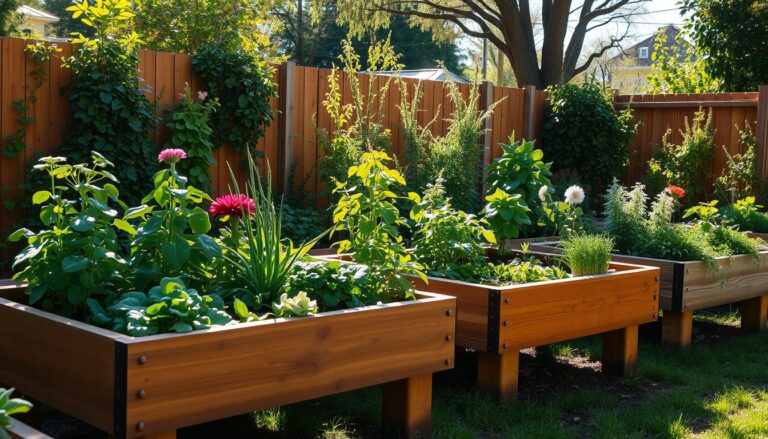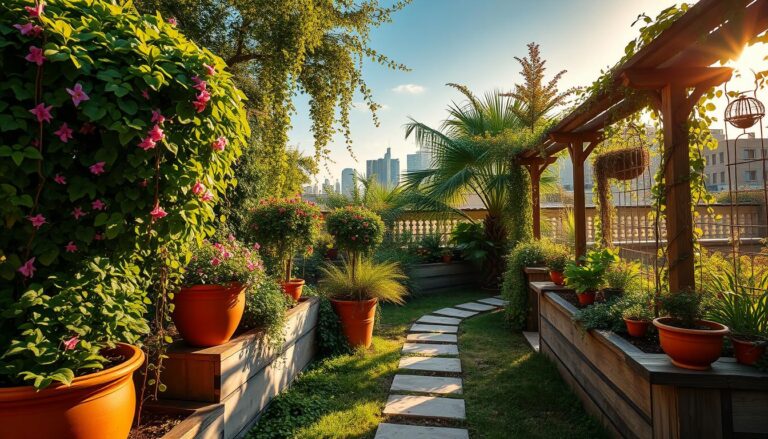Unlocking the Secrets of Organic Gardening for Beginners
This post contains affiliate links, meaning I may receive a small commission if you make a purchase through my links, at no extra cost to you.
Imagine stepping into your backyard and picking fresh produce for dinner tonight. Creating a thriving edible garden is possible, starting with the basics of self-sustaining garden practices.
As a beginner, you might feel lost with all the options and techniques. But, with some guidance, you can unlock the secrets to a bountiful harvest. Our beginner’s guide will show you how to create a organic garden that gives you fresh fruits and veggies all season.
Key Takeaways
- Understand the benefits of organic gardening for beginners
- Learn how to design a self-sustaining edible garden
- Discover the essential steps to create a thriving organic garden
- Get tips on maintaining a healthy and productive garden
- Explore the importance of companion planting in organic gardening
What is Organic Gardening?
Organic gardening is more than just growing plants. It’s about creating a healthier environment. This method avoids synthetic fertilizers and pesticides, focusing on sustainability and eco-friendliness.
Definition of Organic Gardening
Organic gardening is a holistic way to grow plants. It uses natural materials and techniques to keep soil healthy and conserve water. This approach emphasizes compost and manure to improve soil and plant growth.
Benefits of Going Organic
Organic gardening has many benefits. It reduces pollution and promotes biodiversity. It also improves soil health and supports a healthier ecosystem. Plus, organic produce is often more nutritious and tastes better.
Some key benefits of organic gardening include:
- Reduced environmental impact
- Improved soil health
- Increased biodiversity
- Healthier and more nutritious produce
The Difference Between Organic and Conventional Gardening
The main difference is the use of synthetic chemicals. Conventional gardening uses chemicals to control pests and promote growth. Organic gardening, on the other hand, uses natural methods for the same goals.
Choosing organic gardening makes your garden healthier and supports a sustainable future. As you garden, you’ll find many rewards from using organic practices.
Getting Started with Organic Gardening
Starting your organic garden can be both exciting and a bit scary. But with the right help, you’ll soon be growing your own food. To make your garden thrive, you need to learn how to plant and get the right tools.
When you start, think about a few important things. These include picking the best spot, knowing your soil, and getting the tools you need.
Choosing the Right Location
The spot you pick for your garden is key to its success. Look for places with lots of sunlight, good drainage, and easy access. Most plants need at least 6 hours of sunlight a day.
Here are some things to think about when picking a spot:
- Sunlight: Make sure your garden gets enough sun.
- Drainage: Stay away from places where water collects.
- Accessibility: Pick a spot that’s easy to get to for upkeep.
Understanding Your Soil
Soil health is the base of a great organic garden. Knowing your soil’s type, pH, and nutrients is key. You can test it with a DIY kit or send it to a lab.
To make your organic garden soil better, add natural stuff like compost or manure. These can change the pH and add nutrients for your plants.

Essential Tools for Beginners
As a beginner, you’ll need some basic essential tools for gardening. You’ll need a fork, trowel, rake, and watering can. You might also want to think about an aeroponic tower or vertical garden to save space.
Other tools to think about include:
- Garden gloves to keep your hands safe.
- A garden cart or wheelbarrow for moving stuff.
- A watering system, like drip irrigation, to save water.
Selecting Plants for Your Organic Garden
Choosing plants for your organic garden can seem hard at first. But, with some tips, it becomes exciting and rewarding. Think about what you like to eat, how much space you have, and if your plants will do well in your area.

Best Vegetables for Beginners
For beginners, start with easy vegetables to grow. Leafy greens like lettuce and spinach, tomatoes, cucumbers, and carrots are great. They taste good and are easy to take care of.
Remember to think about your climate and soil when picking vegetables. For example, in hot and dry places, choose drought-resistant veggies that need less water.
Choosing Organic Seeds vs. Non-Organic
Deciding between organic and non-organic seeds is key for organic gardeners. Organic seeds are made without synthetic fertilizers, pesticides, or GMOs. This fits with organic gardening’s values.
Non-organic seeds can work, but they might not do as well in organic gardens. They’re often made for farming that uses chemicals.
Companion Planting Basics
Companion planting means growing different plants together to help each other. For instance, marigolds with tomatoes can keep nematodes away. Basil can also make tomatoes taste better.
This method helps create a balanced garden. It also means you might use fewer chemicals, which is good for organic gardening.
Soil Health and Fertility
Healthy soil is key to a successful organic garden. Keeping the soil healthy and fertile is essential. We’ll look at why this matters, including natural amendments, cover crops, and crop rotation.
Importance of Healthy Soil
Soil health is vital for a productive garden. It supports many microbes that help break down organic matter. This makes nutrients available to plants.
Start by testing your soil. This tells you its type, pH level, and nutrient content. With this info, you can choose the right soil amendments for your plants.
Natural Amendments for Soil
Natural amendments are crucial for soil fertility. Compost, manure, and green manure are great for nutrients. They improve soil structure and fertility.
For example, compost helps the soil hold water better. It also slowly releases nutrients to plants. Choose amendments that fit your soil’s needs.

Cover Crops and Crop Rotation
Cover crops and crop rotation are important for soil health. Cover crops protect the soil and improve its structure. They also increase biodiversity.
Crop rotation manages pests and diseases. It also boosts soil fertility and reduces the need for external inputs. Legumes in your rotation can naturally increase soil nitrogen.
For instance, growing corn, beans, and squash together is beneficial. This traditional method promotes soil health and uses space wisely. It also reduces pest problems.
Pest Management in Organic Gardening
Pest control is key to a healthy organic garden. As an organic gardener, you’re not just growing plants. You’re creating a balanced ecosystem that thrives without harming the environment. Effective pest management is crucial to achieving this balance.

Common Pests and How to Identify Them
Knowing the types of pests that can affect your garden is the first step. Common pests include aphids, whiteflies, spider mites, and slugs. Each pest has its own characteristics and needs specific control methods.
Aphids are small, soft-bodied insects found on leaves or stems. They feed on plant sap, causing curled or distorted leaves.
- Aphids: These tiny insects feed on plant sap, causing curled or distorted leaves.
- Whiteflies: These pests are known for transmitting diseases between plants.
- Spider mites: These microscopic pests cause yellowing or bronzing of leaves.
- Slugs: Slugs are nocturnal pests that chew holes in leaves and fruits.
Organic Pest Control Solutions
Organic pest control methods aim to minimize harm to the environment. They effectively manage pest populations. Some effective solutions include:
- Neem oil: Derived from the seeds of the neem tree, this oil disrupts the life cycle of insects.
- Insecticidal soap: This soap is made from natural ingredients and is effective against soft-bodied pests.
- Diatomaceous earth: A powder made from fossilized algae, it dehydrates and kills insects.
These methods can be used alone or together for the best results. It’s also important to rotate between different control methods. This prevents pests from developing resistance.
The Role of Beneficial Insects
Beneficial insects are vital in organic pest control. They prey on or parasitize pests, helping to maintain a balanced ecosystem. Some beneficial insects include:
- Ladybugs: Known for consuming aphids and other soft-bodied pests.
- Lacewings: These delicate insects are predators of aphids and other pests.
- Parasitic wasps: Some species of wasps are parasitic, laying their eggs inside pest insects.
By creating a welcoming environment for these beneficial insects, you can enhance your garden’s natural balance. This can involve planting a diverse range of flowers that attract beneficial insects. Or avoiding broad-spectrum pesticides that harm both pests and beneficial insects.
Watering Techniques for Organic Gardens
Using the right watering methods is key for a healthy organic garden. Water is essential for plants to grow. Misusing water can harm your garden. Learning the best watering techniques will help your garden thrive.

Best Practices for Watering Plants
Watering plants right is crucial for their health. Water in the early morning or late evening to cut down on evaporation. Water at the base of the plants to avoid fungal diseases.
Check soil moisture by feeling it with your finger. A moisture meter can also help. These steps ensure your plants get the right amount of water.
Importance of Drip Irrigation
Drip irrigation is a smart way to water plants. It sends water straight to the roots, saving water and preventing diseases. This method makes watering more efficient and effective.
Drip irrigation systems can be tailored to your garden’s needs. They work well for different plants and garden designs. Investing in a drip irrigation system is a smart choice for efficient watering.
Rainwater Harvesting Methods
Rainwater harvesting saves water and cuts down on municipal water use. It collects rainwater for plants during dry times. You can use rain barrels or cisterns to harvest rainwater.
Install a rain barrel under a downspout to collect rainwater. This water can then water your plants. Rainwater harvesting makes your garden more sustainable and self-sufficient.
Organic Gardening Practices to Embrace
As you explore organic gardening, it’s key to use practices that help your garden grow well. Organic gardening is more than avoiding chemicals. It’s about making a balanced space that’s good for you and the planet.
Mulching is a vital practice. It keeps the soil moist and stops weeds. Using organic mulch like wood chips or straw saves water and cuts down on weeding. It also helps control soil temperature, keeping it cool in summer and warm in winter.
Mulching Benefits and Techniques
Choosing the right mulch and applying it correctly is crucial. You can use wood chips, straw, or leaves for mulch. Make sure to keep mulch a few inches from plant stems to avoid rot. A 2-3 inch layer is enough, and you’ll need to add more as it breaks down.

Using Compost Effectively
Composting is another key practice. It turns organic waste into a soil booster. Composting reduces waste, improves soil, and feeds your plants. To compost well, mix “green” materials like food scraps with “brown” materials like leaves. Regularly turning and checking the compost pile speeds up the process.
- Start with a mix of 2/3 “brown” materials and 1/3 “green” materials.
- Keep the compost pile moist, like a damp sponge.
- Turn the compost pile regularly to aerate it.
Understanding Organic Fertilizers
Organic fertilizers are vital for organic gardening. They give nutrients slowly, helping plants grow without harming the environment. Examples include fish emulsion, bone meal, and manure tea. Always follow the instructions and start with small amounts to avoid over-fertilizing.
By using these organic gardening practices, you can make a garden that’s healthy and sustainable. Whether you’re using mulch, compost, or organic fertilizers, the goal is to work with nature, not against it.
Seasonal Considerations in Organic Gardening
Organic gardening needs you to know about seasons. Each area has its own seasons that change what plants grow best and how to garden. This knowledge is key for a healthy garden.
Planting Calendars for Different Regions
Make a planting calendar for your area for great organic gardening. It should show when to plant different crops. This depends on temperature, rain, and pests.
In the U.S., the Northeast and Southwest have very different planting calendars. Knowing these differences helps you plan better. This way, you can grow more and face fewer problems.
To make a planting calendar, find your area’s frost dates. This tells you when to start seeds indoors and move them outside. Talk to local gardeners, use online resources, or gardening books for your area.
| Region | Best Crops to Plant in Spring | Best Crops to Plant in Summer | Best Crops to Plant in Fall |
|---|---|---|---|
| Northeast | Lettuce, Spinach, Peas | Tomatoes, Peppers, Cucumbers | Broccoli, Kale, Carrots |
| Southwest | Radishes, Beets, Onions | Okra, Southern Peas, Squash | Brussels Sprouts, Cauliflower, Lettuce |
Preparing Your Garden for Winter
Winter is coming, so get your garden ready. Clean up, keep the soil healthy, and plan for next year. Remove dead plants and add compost or manure to the soil.
Use cover crops or mulch to keep the soil from washing away and to keep it moist. Start planning for next year by ordering seeds, preparing tools, and thinking about new garden ideas.

Tips for Year-Round Gardening
To keep your garden busy all year, try succession planting. Plant small batches of seeds every few weeks for a steady harvest. Use cold frames, hoop houses, or indoor systems to grow longer.
For advanced gardeners, consider an aeroponic tower garden. It’s a great way to grow many crops all year. By understanding seasons, you can have a productive garden every day of the year.
Troubleshooting Common Organic Gardening Problems
Organic gardening can come with its own set of challenges. You might face issues like weeds, plant diseases, or poor growth. Knowing how to tackle these problems can make a big difference.
Dealing with Weeds Naturally
Weeds can be a big problem in gardens, taking up space and resources. Instead of using harsh chemicals, try natural methods to control weeds. Mulching helps keep weeds down and keeps the soil moist.
You can also use non-pesticide weed killers like boiling water or vinegar. These methods are safe for the environment.

Recognizing and Managing Plant Diseases
Plant diseases can really set back your garden. It’s important to spot problems early. Look for signs like discoloration, lesions, or odd growth.
Once you find a disease, use organic treatments. Crop rotation and keeping your garden clean also help prevent disease spread.
| Disease | Symptoms | Management |
|---|---|---|
| Powdery Mildew | White, powdery coating on leaves | Use organic fungicides, improve air circulation |
| Root Rot | Soft, rotting roots | Improve drainage, avoid overwatering |
Solutions for Poor Growth
If your plants aren’t growing well, there are a few things to check. First, look at the soil. Adding compost can really help. Make sure your plants have enough light and water.
- Check soil pH and adjust as necessary
- Use compost to enrich soil nutrients
- Ensure adequate light and watering
Expanding Your Organic Gardening Knowledge
As you keep learning, your organic garden will grow. Discovering new ways to garden can make your garden flourish. It will also bring joy and beauty to your life.
Resources for Continued Learning
There are many ways to learn more about organic gardening. You can find online tutorials, blogs, books, and documentaries. These resources can help you grow your gardening skills.
Consider learning about aquaponic farming. It’s a method that grows plants and raises fish together.
Joining Local Gardening Communities
Meeting other gardeners in your area is beneficial. Look for local gardening clubs or cooperatives. They offer a chance to share knowledge and learn from others.
Attending Workshops and Events
Workshops and events are great for learning from experts. Many groups offer classes on organic gardening, composting, and pest control. These events help you stay updated and improve your gardening skills.
FAQ
What is the difference between organic gardening and conventional gardening?
Organic gardening doesn’t use synthetic fertilizers, pesticides, or genetically modified organisms. Conventional gardening often does, to help plants grow and fight pests.
How do I start an organic garden?
Start by picking a spot with good sunlight and soil. Choose the right plants and get the tools you need. Knowing your soil and making it better is key.
What are the benefits of using organic seeds?
Organic seeds don’t have GMOs or pesticides. They help your garden grow healthier and more sustainably. Plus, you can save your own seeds, cutting down on buying from stores.
How can I maintain healthy soil in my organic garden?
Keep your soil healthy with natural amendments, cover crops, and crop rotation. These steps make your soil better, reducing the need for chemical fertilizers.
What are some effective organic pest control methods?
To control pests organically, introduce beneficial insects and use natural repellents. Also, keep your garden clean. These methods protect your garden and the environment.
How can I conserve water in my organic garden?
Save water with drip irrigation, rainwater harvesting, and mulching. These methods cut down on waste and make watering more efficient.
What is the role of composting in organic gardening?
Composting is vital in organic gardening. It turns waste into a valuable resource. Compost makes your soil better, reducing the need for chemical fertilizers.
How can I deal with weeds in my organic garden?
Fight weeds with mulching, hand-weeding, and cover cropping. These methods stop weeds without harming the environment.
What are some common mistakes to avoid in organic gardening?
Avoid not preparing the soil, not rotating crops, and not watching for pests and diseases. Knowing these mistakes helps keep your garden healthy.
How can I continue learning about organic gardening?
Keep learning by reading books, taking online courses, and joining local gardening groups. Workshops and events offer valuable knowledge and connections.
What are the benefits of using lava rocks in landscaping?
Lava rocks improve drainage, prevent soil erosion, and add beauty to your garden. They’re also great for decorating.
How can I use aeroponic systems in my organic garden?
Aeroponic systems grow plants in a nutrient-rich mist, not soil. This method boosts yields, saves water, and promotes healthy growth.
What are the benefits of using aquaponics in organic gardening?
Aquaponics combines growing plants and raising fish in a balanced system. It increases yields, saves water, and supports a healthy ecosystem.







